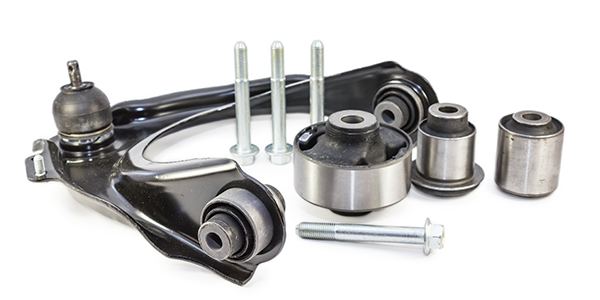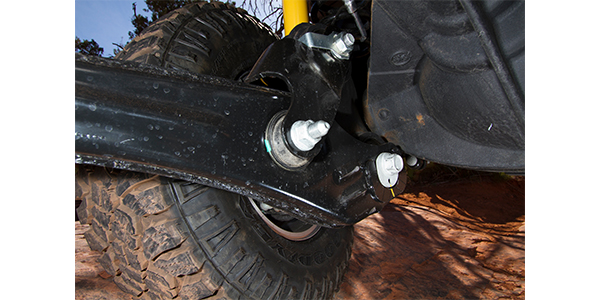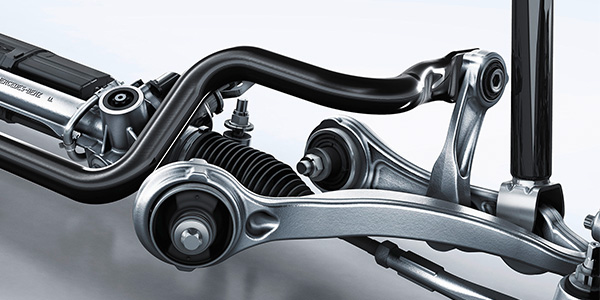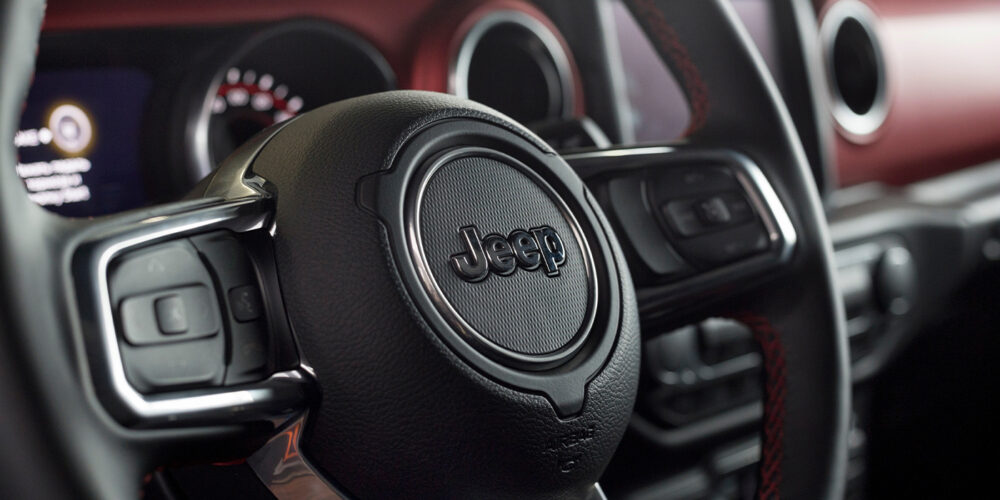
Most suspension system components pivot upon a rubber bushing that is compressed between an inner and outer metal sleeve. Because the compressed rubber bushing has no moving parts, it allows a maximum range of travel throughout a single plane without the frictional wear created in a conventional metal-to-metal bushing. Unfortunately, as the bushing ages, it acquires a “set” that is easily disturbed when a vehicle’s steering system is realigned. When this happens, the bushing begins to separate from its metal sleeve and becomes, in essence, a frictional wearing component.
As the rubber begins to twist inside the sleeve, excess clearance develops in the suspension system that, in turn, causes changes in steering and suspension geometry. In most cases, a rubber bushing separated from its shell or sleeve develops a characteristic “black ring” around its outer circumference. Hydraulic mounts may leak and there will be evidence of a leak around the bushing.
BUSHING INSPECTION
Oftentimes, a bushing will fail because of exposure to extreme heat or fluids from the engine or transmission. If the problem is not addressed, the new component will fail sooner than expected. In many cases, a worn axle seal on a transmission or transfer case can kill a control arm bushing very quickly.
Worn suspension bushings may cause excessive side-to-side caster angle and toe angle changes during steering, braking and acceleration driving modes. More subtle symptoms of worn suspension bushings are inconsistent camber and caster angle readings, or the need to make major positive camber angle adjustments during the wheel alignment process.

The best way to inspect suspension bushings in a loaded condition is to move the vehicle onto a drive-on lift. During your inspection process, it’s important to visualize exactly how the chassis loads each bushing. Looking from the driver’s seat, the vehicle loads the left front and rear independent suspension in a clockwise direction. The right front and rear independent suspension loads in a similar, but counter-clockwise manner.
When suspension loading is taken into account, it’s easy to see why the inner and outer bushing sleeves should appear to be concentric. If the bushing doesn’t appear to be concentric, the rubber inside the bushing has lost its resiliency and has taken a “set” because of suspension system loading.
Less obvious, but still important, we should also understand that braking forces tend to twist the suspension in the direction of wheel rotation. Although brake torque might be less of a factor than vehicle load when analyzing suspension wear, it should be taken into account if the customer complaint involves a brake pull or brake clunking issue.

Similarly, the thrust developed by the driving wheels tends to pull the suspension inward, toward the vehicle’s centerline. If the vehicle is front-wheel drive and has front-mounted steering linkage, the toe-in effect may be less than if the vehicle has rear-mounted steering linkage.
Many bushings are designed with voids in the material to allow a bushing to be more compliant in one direction, while allowing some play in the other direction. Some bushings use fluid-filled chambers that can control the stiffness of the bushing depending on the amount and frequency of the movement.
Many modern bushings must be properly oriented in the suspension component. If it is not properly aligned, it will cause ride quality problems and premature failure of the bushing. When these types of bushing are installed, they need to have the final tightening and torque applied when the suspension is loaded. Worn bushings and tie rod ends can cause knocking noises and toe angle changes during acceleration and deceleration driving modes.
The key to diagnosing worn rubber suspension bushings is to visualize the forces taking place in the suspension system, and then use that information to inspect the bushings for wear patterns that may be otherwise overlooked in standard “dry-park” and visual inspection testing.
Article courtesy Brake & Front End.















